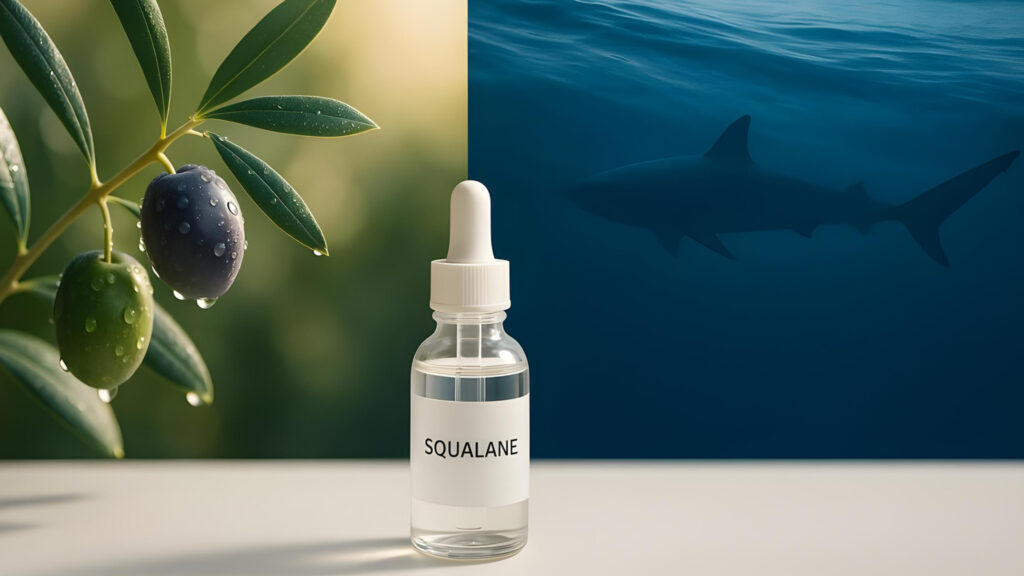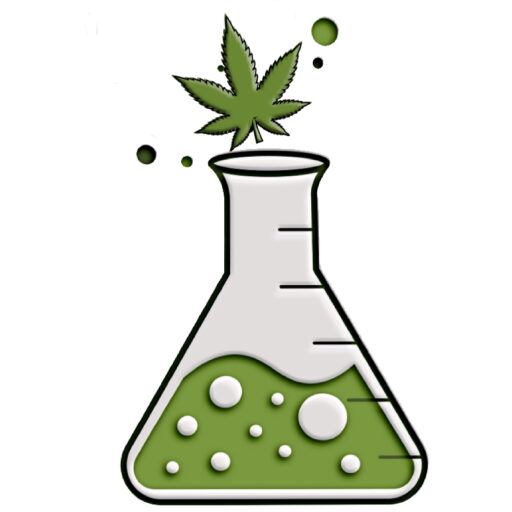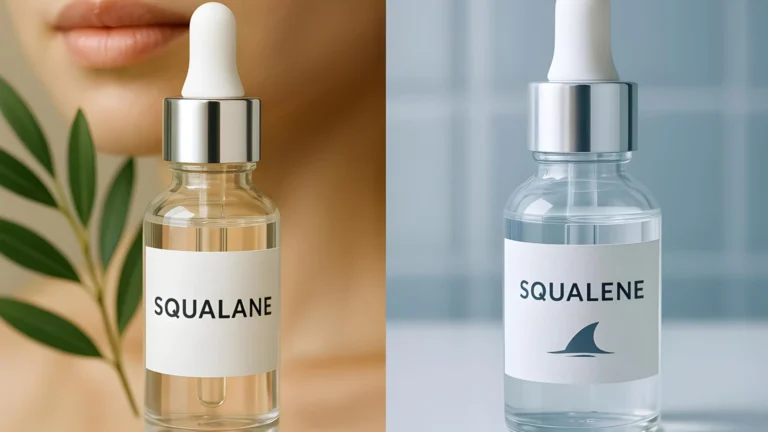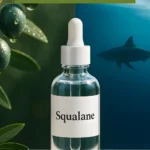Squalane vs Squalene? Have you ever wondered why some skincare products list Squalane while others say Squalene? The names are nearly the same, and both come from nature, but understanding the real difference can help you make better choices for your skin and the environment.
Table of Contents
What Is Squalene?
Squalene (spelled with an “e”) is a natural compound produced by our own bodies. It’s part of our sebum, the oil that keeps our skin hydrated and protected. Squalene is found in the livers of sharks, as well as in some plant oils like olive and amaranth.
Most Squalene used in industry has historically come from deep-sea shark livers because it’s a cheap and concentrated source. However, the harvesting of shark livers has a huge environmental impact and contributes to the decline of shark populations worldwide. Squalene is also used in some vaccines, where its instability isn’t an issue because the vials are sealed from air.
One major drawback of Squalene is its instability. When exposed to air, it oxidises quickly. This leads to rancidity and the production of free radicals, which are damaging to the skin and accelerate ageing.
Why Is Shark-Derived Squalene Still Used?
Cost is usually the reason. Shark liver Squalene is cheaper to extract in bulk. The beauty industry alone is responsible for using the vast majority of shark-derived Squalene globally, which equates to the deaths of millions of sharks each year. This has contributed to the endangered status of many deep-sea shark species. There is an interesting article the BBC did about shark liver harvesting here.
If you’re concerned about animal welfare or sustainability, always look for Squalane sourced from olives, sugarcane, or other plants, and avoid products listing Squalene from animal sources.
What Is Squalane?
Squalane (spelled with an “a”) is simply the stable, hydrogenated version of Squalene. Through hydrogenation, Squalene becomes Squalane, which is resistant to oxidation and has a long shelf life. Today, high-quality Squalane is mostly derived from olives, rice bran, or sugarcane, making it a sustainable and vegan option.
Squalane offers the same emollient benefits as Squalene, helping to moisturise, soften, and protect the skin. The big advantage is that Squalane stays fresh and does not produce harmful free radicals. This is why I choose to make my skincare products with Squalane instead of Squalene.
Key Differences Between Squalane vs Squalene
There are a few important distinctions:
- Stability: Squalene oxidises quickly when exposed to air, turning rancid and producing free radicals. Squalane is hydrogenated, making it stable and non-oxidising, so it lasts much longer in your products and on your skin.
- Source: Most Squalene in the past was harvested from shark liver, which has a heavy environmental toll. Squalane is now usually derived from olives, rice bran, or sugarcane, making it a much more sustainable and cruelty-free choice.
- Safety: Because of its stability, Squalane is a safer ingredient for skincare, especially for those with sensitive or compromised skin barriers.
- Effect on Skin: Both Squalene and Squalane are excellent emollients, but Squalane is my preferred choice due to its stability and shelf life.

Benefits of Olive Squalane for Skin
I use Olive Squalane in my own formulations because it delivers everything you want in a moisturising oil, without the ethical or stability issues. Here’s what makes olive squalane special.
- Suited to all skin types: Olive Squalane is a great moisturiser that is lightweight, non-greasy, and easily absorbed into the skin. It helps keep the skin barrier strong and healthy.
- Balances Oil Levels: Squalane closely mimics your skin’s natural oils, which helps keep oil production in check. This is especially helpful for oily or acne-prone skin, as it can prevent excess shine and reduce breakouts. Plus, because it’s non-comedogenic, it won’t clog your pores.
- Deeply Hydrating: Squalane delivers lasting moisture, soothing dry, flaky, or rough skin. It helps lock in hydration, leaving your skin feeling soft, smooth, and comfortable all day.
- Gentle for sensitive and problem skin: Safe for those with eczema, psoriasis, and sensitive skin. It keeps dry skin hydrated and flexible, so less likely to crack or itch.
- Enhances other oils: Makes heavier oils, like Castor oil, feel lighter and easier to use. This is a really overlooked benefit. So many great oils like Macadamia, Avodado and even Shea Butter feel much lighter and more elegant when applied when blended with Squalane.
- Antioxidant protection: Helps shield the skin from environmental stress and reduce the appearance of dark spots.
- Anti-ageing benefits: Softens fine lines, smooths skin texture, and keeps your complexion looking youthful.
- This is a great Cannabis-Infused Squalane Cleanser you can make at home.
Is Squalane Good for Eczema and Psoriasis?
If you’ve got eczema, psoriasis, or just sensitive, irritated skin, you’ll know how hard it can be to find products that don’t make things worse. Squalane is often recommended for these conditions, and for good reason.
Squalane is naturally soothing and deeply moisturising. It helps restore and strengthen the skin barrier, which is often damaged in eczema and psoriasis. By locking in moisture and keeping the skin flexible, Squalane can help reduce dryness, flakiness, and the itchy, tight feeling that comes with flare-ups.
One of the best things about Squalane is how gentle it is. It’s non-comedogenic, so it won’t block pores, and it rarely causes irritation or allergic reactions. Because it mimics your skin’s natural oils, it sinks in easily and helps calm down inflammation without feeling greasy or heavy.
A lot of people with eczema and psoriasis find relief from regular use of Squalane, whether it’s on its own or blended into creams and balms. While it’s not a cure, The National Eczema Association say it’s a great choice for supporting your skin’s health and comfort.
If you’re struggling with these conditions, look for moisturisers or serums with olive-derived squalane, and always patch-test first to be sure your skin loves it as much as I do. Another ingredient worth exploring for skin hydration and barrier support is Glycogen (PhytoSpherix®).
Another powerful active for eczema and acne-prone skin is Tamanu oil. Here’s a dedicated guide all about Tamanu oil’s healing properties and use cases.

Squalane for Hair and Beard Care
Squalane is not just for skin. You can use it to boost your hair and beard routine, too.
- Protects against heat damage: Apply before washing or heat styling to guard hair strands.
- Adds shine: A small amount makes hair and beards look glossier and healthier.
- Reduces breakage: Regular use can strengthen hair and prevent split ends.
How to Use Squalane
- Apply a few drops to clean, damp skin after water-based serums and before heavier creams or sunscreen.
- Use as a daily facial oil, or mix a drop into your moisturiser.
- Smooth a little over hair ends or into your beard for softness and shine.
Check out my DIY Squalane Cleanser Recipe for an easy way to add this hero ingredient to your daily skincare routine.
Is Squalane Vegan and Cruelty-Free?
If your Squalane is made from olives, rice, or sugarcane, it’s vegan and cruelty-free. Always check the label to make sure your product doesn’t use animal-sourced Squalene.
*As an Amazon Associate, I earn from qualifying purchases.
Squalane and Cannabis: Can You Infuse Them Together?
If you’re thinking of making a cannabis-infused Squalane oil, here’s what you need to know. Squalane itself is a brilliant, skin-friendly oil, but it’s not the best option for infusing cannabis. Even though Squalane is reasonably stable when heated, the temperatures needed for a good infusion are just a little bit too high. A good infusion also takes 2 to 3 hours which is not good for the integrity of Squalane.
The solution is simple and works a treat: first, infuse your cannabis into something heat-stable like Coconut oil or MCT oil which can handle the decarboxylation temps and soak up all the active compounds. Once your infusion is done and cooled, you can blend it with Squalane.
This way, you get the skin-loving benefits of Squalane with the added bonus of cannabinoids, and the texture feels absolutely lush. Perfect for a face oil, serum, or anything you want to glide onto your skin and soak in fast.
Conclusion
If you want safe, effective skin moisturisation and you care about sustainability, olive-derived Squalane is the clear winner. It’s stable, vegan, non-greasy, and gives all skin types exactly what they need. Shark-derived Squalene is outdated and comes at too high a cost for the environment. For more about natural skincare ingredients and making your own products at home, browse the Aromatherapy section of my site.
🎧 Listen Instead
Prefer listening? Play it here or catch it on your favourite platform:
FAQ
What is the difference between squalane and squalene?
The main difference is stability and source. Squalane is the stable, hydrogenated version of squalene and is usually made from olives or sugarcane. Squalene is less stable, oxidises quickly, and is often sourced from shark liver. Squalane is safer and more sustainable for skincare.
Is squalane or squalene better for skin?
Squalane is better for skin because it is stable, lightweight, and non-comedogenic. It moisturises without clogging pores and does not turn rancid. Squalene can oxidise quickly, which may harm the skin.
Is squalane vegan?
Squalane is vegan if it is made from olives, sugarcane, or rice bran. Always check the label to make sure your product does not use animal-sourced squalene.
Can you infuse cannabis in squalane oil?
Squalane is not ideal for directly infusing cannabis because it does not extract cannabinoids efficiently. It is better to infuse cannabis in a heat-stable oil like coconut or MCT oil, then blend that with squalane for a lightweight and luxurious feel.
Can squalane be heated?
Yes, squalane can be gently heated for blending or making creams. Heat it to no more than 80°C (175°F) for a few minutes to ensure it is not damaged. It is very stable and will not lose its benefits at normal DIY skincare temperatures.
Is squalane safe for acne-prone skin?
Yes, squalane is non-comedogenic and suitable for acne-prone skin. It helps balance oil production and does not clog pores.

If you liked this blog post, I would love it if you shared it with a friend.
If you use Pinterest, please pin this post.
*As an Amazon Associate, I earn from qualifying purchases.


 Spotify
Spotify

